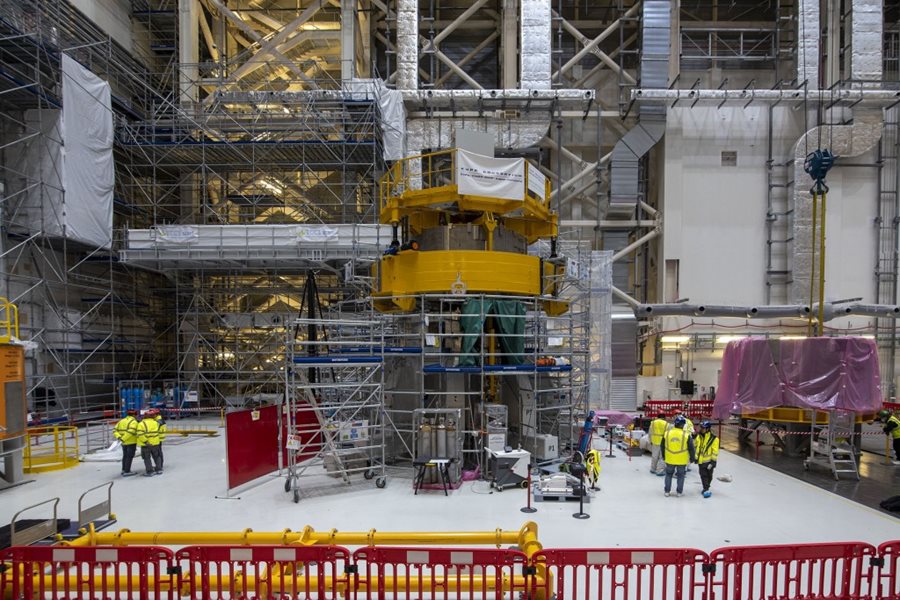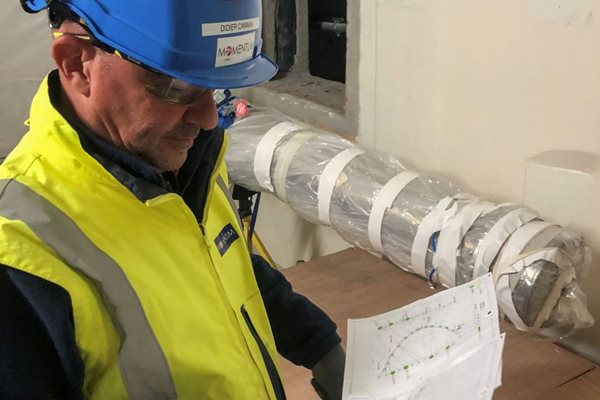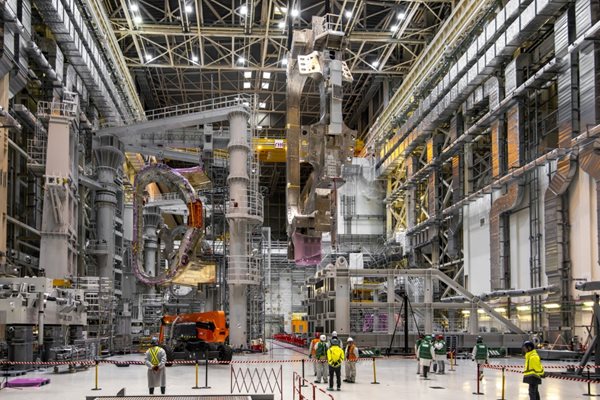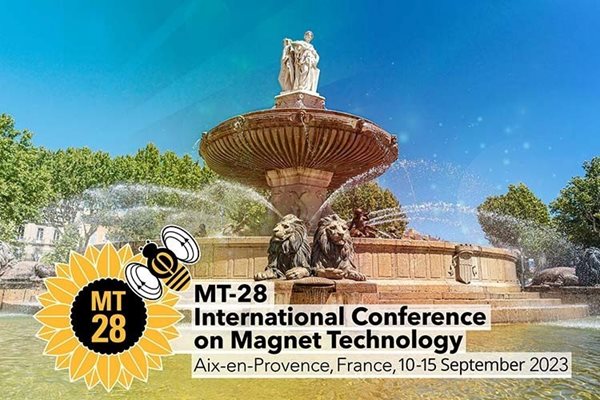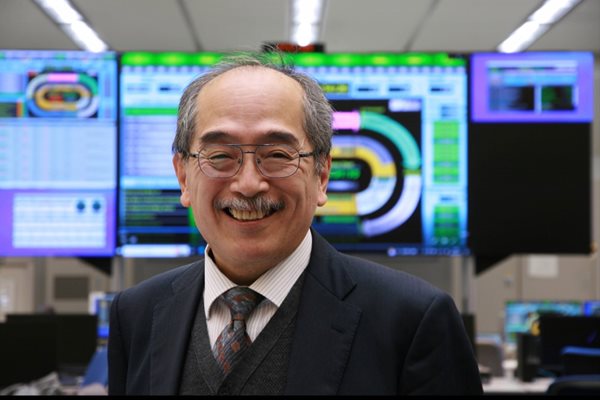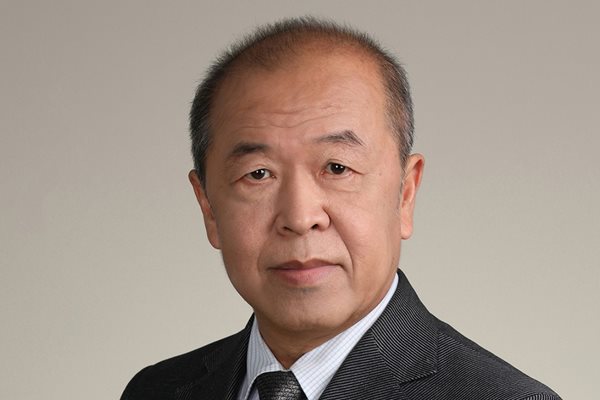
you're currently reading the news digest published from 23 Jan 2023 to 30 Jan 2023
featured3
of-interest2
publication2
press14
featured
Central solenoid assembly | First sequences underway
What does it take to assemble the magnet at the heart of ITER? Heavy lifting, unerring accuracy, and a human touch. The central solenoid will be assembled from six cylindrical modules stacked one on top of the other. Weighing 110 tonnes and standing 2 metres high, each module is massive in its own right. But the modules are not the only heavy objects that will make up the overall structure. Eighteen metal blocks, each weighing 6 tonnes, will brace the composite magnet from the bottom (9 lower key blocks) and the top (9 upper key blocks). Interior and exterior vertical tie plates will connect the key blocks to form a cage around the central solenoid and compress the modules in operation, adding more than 110 tonnes to the assembly. The stacking process requires lifting and then accurately positioning these cumbersome objects. The team will use special tools designed and developed by US ITER* as well as highly accurate measurement devices and techniques to align components and make sure the composite magnet is level to within a few millimetres. Stacking the modules and building the cage The first module to arrive at ITER was placed on the central solenoid assembly platform in July 2022. The platform, a robust table with nine legs on seismic isolators, was specially designed to bear the mass of the central solenoid magnet and supporting structures. Several steps were carried out prior to placing the first module. First, hydraulic leveling jacks and laser trackers were used to carefully level the platform. Air gaps were filled with concrete to lock in the level and the platform's legs were anchored into the floor with shear pins. Then, the nine lower key blocks were attached to the assembly platform to provide a base for the tower. Unlike the assembly platform, the lower key blocks will be transferred inside the ITER machine, where they will continue to act as a foundation for the magnet tower. Finally, a fibreglass plate was placed on top of the lower key blocks—and the first module now sits on this plate. The layer of fibreglass acts as a low-voltage insulation—keeping the elements of the support structure electrically isolated. But that is not the only purpose of this layer. The thickness of the fibreglass was machined specifically to adjust the total height of the stack. "We know we'll have to accommodate minor variations in module height, while targeting a specific height of the entire assembly," explains Carl Cormany, superconductor engineer in the Magnet Section. 'And that's one of the jobs of this bottom plate. Each module is normally just over two metres tall and four metres in diameter. But for us, a deviation of 20 mm for the entire stack of six will be too much—and you can't predict the deviation until you've made the modules. A module might wind up five millimetres shorter or taller than you thought. Then the stacking process might result in further deviation. The fibreglass plates at the bottom and the top of our stack give us some capacity to adjust.' The first sequence of central solenoid assembly will be to install the three lower modules on top of the key blocks. These lower modules will be attached to their source of power through heavy steel-jacketed busbars (which also supply liquid helium for cooling through specialized joints) before the next three modules are added. Once all six modules are stacked and joined to their extensions, the upper key blocks will be put on top of the last module, and tie plates—each about 15 metres long—will attach the upper key blocks to the lower key blocks. Eighteen tie plates will be used on the outside and nine on the inside, creating a powerful support cage. 'The cage is needed to hold the magnets together during operational events where the magnets repel one another,' explains Cormany. 'Sometimes the polarities of the magnets will cause the modules to attract each another. But in other situations—including certain operating scenarios—polarities will be reversed in neighbouring magnets, causing adjacent magnets to repel with tremendous force.' The different elements of the support structure work together to resist this force. 'The upper key blocks have five cylinders in them that serve as pistons. We push the cylinders down, smashing the modules together and stretching the tie plates. This provides an enormous compressive force of 210 meganewtons—easily enough to overcome the forces repelling the magnets, which are in the range of 60 meganewtons.' To put these numbers in perspective, United States space shuttles required about 30 meganewtons of thrust on lift off. Tools for lifting, positioning and drilling The dedicated tools designed by US ITER include the assembly platform; a lifting device to hoist the modules and stack them on top of one another with millimetre accuracy; a man-lift to allow operations to be performed inside the inner bore of the modules; a drill guide fixture for shear pin holes (shear pins are inserted in these holes to minimize relative motion of modules in the stack during operation); and a variety of alignment fixtures and support structures. "The module lifting fixture is designed to grasp the module from all sides to lift it,' says Cormany. 'Nine friction pads spaced around the module exert radial force. It's a little like the way you lift a cup of coffee by cusping your hand around it.' Other tools will be used to make electrical connections and to position the modules precisely. Lasers will establish the exact position of each module relative to the others. If the lasers indicate the module is slightly off target, screws in the laser target mounting brackets can be turned to adjust the position. With the light turn of a screw, a technician will cause the module to move half a millimetre—a reminder that in the end, it will all come together with a human touch. But for now, the team is at the beginning of the assembly process. "In the coming months we will be working closely with our TAC-1 assembly contractor to complete the superconducting electrical connections," says Cormany. "This will involve welding, ultrasonic weld inspection, helium leak testing, electrical installation and high voltage testing. Then we will lift the module one more time for a final alignment to the lower key blocks and proceed to install structural shear pins. This is an interesting period for module assembly as it brings together many disciplines and a team of experts from all across the world." * US ITER is responsible for supplying the central solenoid. This work includes the design, R&D, and fabrication of six coil modules (plus one spare) from superconducting coils supplied by Japan, the associated support structure, assembly tooling, bus extensions, and cooling connections. The ITER Organization is responsible for the assembly of the central solenoid stack in the ITER Assembly Hall.
Assembly | The eyes of ITER
Supervisors ensure compliance and completion as machine and plant assembly forges ahead. In Greek mythology, Argus was considered an ideal guardian because his hundred eyes made him all-seeing. Of course, there is no hundred-eyed god at ITER, but there is the next best thing: the eyes of construction supervisors who constantly scrutinize the worksite to guard against delays and assembly errors. 'The job is to watch,' explains Didier Camman, who is a construction supervisor deployed by MOMENTUM, the Construction Management-as-Agent (CMA) that oversees assembly work at ITER under the overall direction of the ITER Organization. 'I am the eyes of the ITER designers, engineers, and managers to make sure work is being done on schedule and according to technical specifications.' The ITER assembly phase represents an enormous construction challenge. In total, the ITER Tokamak and its 15 major plant systems are being built with more than one million components and 10 million parts, sourced through thousands of contracts. On the ground, that translates into a diverse range of construction crews working under different contracts and an encyclopaedic paper trail of technical documentation—from the engineering work packages received from ITER systems owners, to the controllable batches of work assigned under construction work packages and the daily, detailed installation instructions delivered to work contractor teams. So, while every construction project requires supervision due to the inherent differences between work-as-imagined and work-as-done, at ITER it is utterly essential to have extra sets of eyes on the installation process. In the case of Didier, he has been part of the MOMENTUM construction supervisor team at ITER since 2019. Trained as a welder and previously employed by a pipeline company in Toulouse, France, Didier has hands-on construction experience that allows him to quickly assess the work he supervises. 'I try to offer a critical outside perspective to help people see the big picture more clearly,' says Didier. 'We're not there to be friends but we're not the police either; we're trying to move the project ahead together.' There are eight MOMENTUM construction supervisors overseeing work packages at the Tokamak and the Tokamak Complex. This MOMENTUM team is working in an integrated manner with other supervisors from the ITER Organization. Didier is currently assigned to the TCC2 assembly contract for the installation of cooling systems, vacuum pipework, and other infrastructure. The work for this contract is being carried out by META SNC—an international construction partnership composed of Ponticelli Freres SAS, Cobra Instalaciones y Servicios SA, and Empresarios Agrupados Internacional SA. Every morning, Didier grabs a pile of binders with the technical files for current construction tasks and starts walking the site to visit active jobs. One of the big binders under Didier's arm at the moment holds the technical specifications for busbars—high-power electrical conductors that will distribute bursts of power to the ITER in-vessel coils. Manufactured by Vitzro Tech in South Korea, the busbars are between 3 metres and 14 metres in length and weigh several hundred kilograms. There will be more than 190 busbars installed for the TCC2 contract and each one carries a current rated at 15 kiloamperes, which is about one hundred times the amount of electricity entering the average home. As Didier makes his rounds of the Tokamak Complex, he checks the ongoing work on the busbars. First, he confirms each one has been transported into the building without damage to either the busbar or the surrounding infrastructure. Then, he examines the preparation of the surfaces where the busbars will be attached. And, finally, he verifies the bolting and welding. Everything that Didier sees is noted down and flows up through the construction hierarchy. The initial reports go to the CMA construction manager, Martial Beaury, and any issues are flagged to MOMENTUM's project delivery manager, Marina Gómez Fernández, who works hand in hand with ITER contract responsible officer Alfonso Marquez. 'Because construction supervisors prevent problems before they happen, they aren't very visible,' says Marina, 'but they are one of the most critical roles in construction.' On the ITER Organization side, Sylvain Chartron of the Construction Management Office oversees the MOMENTUM contract. Prior to arriving at ITER, Sylvain worked on first-of-a kind nuclear projects as well as on offshore wind projects in the Baltic Sea, so he is keenly aware of how crucial it is to detect any issues early on in the process. 'Just like it's easier to solve an issue onshore than once a turbine is out at sea, at ITER it is much better to ensure the construction meets specifications before work moves forward in the Tokamak Complex,' says Sylvain. While in Greek mythology, the hundred-eyed god Argus was eventually lulled to sleep by music played by Hermes, Didier doesn't think ITER's construction supervisors will ever let their guard down. 'It's a privilege to be part of a project with such an important scope,' says Didier. 'At the end of the day, this is the motivation to always go that extra length to make sure no problems occur.'
Component repairs | Removing, displacing and disassembling
A good repair job starts with a cleared workbench, the right tools on hand and a strong vise. This axiom, true for odd jobs in a home workshop, is also true for the component repairs that ITER is preparing for. In this perspective, extensive handling operations were performed last week in the Assembly Hall, with two 330-tonne toroidal fields coils transferred from one standing tool to the other. The displacement operations in the Assembly Hall last week were just the beginning of a giant, slow-motion game of musical chairs. On Monday 23 January and Wednesday 25 January respectively, toroidal field coils TF9 (from Europe) and TF8 (from Japan) were extracted from one of the twin assembly tools (SSAT-1) and moved to the other (SSAT-2). The operation freed the handling tool's wings, which are now ready to receive the thermal shield panels that need to be disassembled from vacuum vessel sector #1(7) in order to be moved to the repair location. This further disassembly of sector module #1(7) on SSAT-1 should keep the teams busy until the end of March/beginning of April. By then, only the vacuum vessel sector that forms the module's core will remain in the handling tool. At that point, toroidal field coils TF8 and TF9 can be transferred back to the wings of SSAT-1 to free up SSAT-2. Vacuum vessel sector #8—presently installed in SSAT-2 with no toroidal field coils yet attached—will be extracted and moved to the upending tool. The tool (this time acting as a 'down-ending' tool), will move the sector to horizontal so that it can be placed on a transport platform and moved to a repair location. SSAT-2 will then stand empty ... but not for long. In late April/early May, a grand and delicate operation will be performed: the lifting of sector module #6 up and out of the Tokamak Pit, where it had been installed in late May 2022, and its transfer to SSAT-2 for disassembly and repair. Removing, displacing and disassembling massive components is not just doing things 'in reverse' to make them accessible for repairs. These operations require creativity, anticipation and adaptation. Last week's faultless transfer of two 17-metre tall, 330-tonne toroidal field coils demonstrated that the ITER teams were up to the task.
of-interest
Recent TEDx talks on fusion
Worth watching: two recent TEDx talks featuring fusion and ITER. In the first, "Why should we make a star on Earth?" EUROfusion's Tony Donné, explains the advantages of fusion--a baseload source clean and safe energy, power dense, requiring only small amounts of fuel and a small footprint for reactor construction, and without any long-lived radioactive waste. He touches on recent accomplishments in the field and the large numbers of industrial spinoffs that have already resulted from investment in fusion research. In the second, "Entering the Fusion Energy Delivery Era," JET's Head of Operations Joe Milnes outlines a bright future for fusion, taking the audience from recent milestones in the fusion world to the turbo-charged current state of play and his hope for a fusion future, where all countries can build reactors based on fuels that are accessible to all. What are the breakthrough technologies that will help us access fusion electricity? What challenges still remain?
MT-28: Student program announced
The 28th International Conference on Magnet Technology (MT-28) will be hosted by the ITER Organization and the French Alternative Energies and Atomic Energy Commission (CEA) in Aix-en-Provence, France, during the week of 10 to 15 September 2023. The MT-28 Local Organizing Committee (LOC) team has planned a dynamic student program to make MT-28 a moment to remember for all participating students. There are grant opportunities, short courses and workshops, best paper awards, recruitment and career opportunities, and fun extracurricular events. See this page for a description of all student events and opportunities. And a reminder to all: abstract submission is open now through 20 February 2023.
